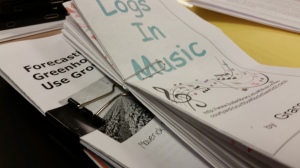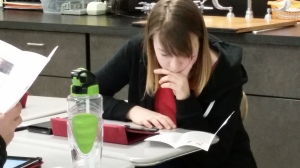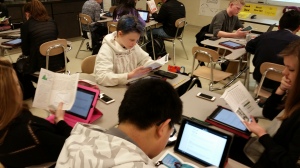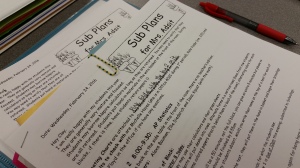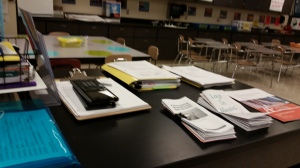Wk 3: Using Table Folders
 Ok, so I’ve wanted to do this for years, but never got my act together. For years, I’ve read blog posts about them, printed the blog posts to highlight/scrutinize the details and asked questions on Twitter, so I knew I needed to incorporate this strategy. This summer I resolved that I. MUST. DO. THIS!
Ok, so I’ve wanted to do this for years, but never got my act together. For years, I’ve read blog posts about them, printed the blog posts to highlight/scrutinize the details and asked questions on Twitter, so I knew I needed to incorporate this strategy. This summer I resolved that I. MUST. DO. THIS!
Where did I get my inspiration?
- I first read about this strategy on Teaching Statistics Blog by @druinok
- Then I found more about ways to implement them on BorschtWithAnna blog by @Borschtwithanna
- Asking on Twitter for some guidance provided direction to ContinuousEverywhereButDifferentiableNowhere blog by @samjshah and Type-AMathLand blog by @typeAmathland
How did I organize?
I took little bits from each of the above blog and wove my own version. Since I wasn’t sure I was going to stick to this idea (such a pessimist!!), I purchased cheap, on sale, two pocket with prong folders from Wallmart. I put large and small group numbers from the Dollar Store on the front of the folders. I also put plastic labels, purchased at Targets Dollar bins, so my students could list their names. Inside the folder, I added the IN and OUT labels with clear packing tape. Finally I inserted a plastic page protector in the prongs to hold the learning targets for the unit….always visible to the group.
I tried to use magazine holders, but the folders didn’t fit in them. Luckily I had some metal library file holders I rescued from the waste bin many years ago (knew they’d come in handy some day!! Such a pack-rat). I spring-clipped them together and added index cards on popsicle sticks taped to the back of the holders. Everything is color-coded by class.
What’s Working?
My students are doing such a great job of picking up their folders daily and using the IN-OUT pockets to turn in items and late work.
The OUT pocket for handing OUT items to students, such as daily handouts, daily formative assessments, exit slips, graded work. I also have instituted that the Recorder of the group paper clips any handouts and work for absent students…time-saver!! Now students immediately get what they need without the line in front of the room at the start of class – Bonus!! It has also been a great way to get work back to them the next day. Of course, if I forget or miss putting something in the pockets, I can still use the Resource Managers to pick up what is needed for their group. Although I don’t put assessments into the OUT pocket, I use the RM to pick up the assessments for the group: I fold the papers over so only the name shows and the score is hidden – takes a little longer, but privacy is preserved.
The IN pocket is great for collecting work in an organized way. Students simply place their completed work in the IN pocket. If a student is absent, they can place their absent work in the IN folder and I get it immediately that day. Also, since I don’t record assessment scores until students look at them and then return to me, this IN pocket works beautifully. Students can write me a note if they need me to look at a problem before putting the grade into the grade book. The table group also reminds each other to return the assessments before they leave for the day and students fold over their own paper to preserve privacy.
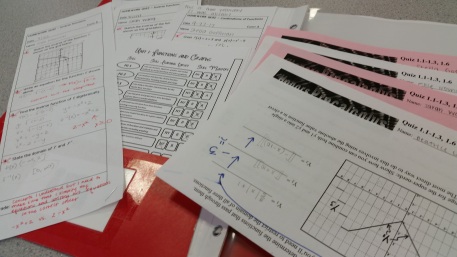
I also like having the learning targets in front of them. I can instantly refer to them and so can the students (although they are also on the unit tab in their Interactive Notebooks…for another post).
Lessons Learned
Stuffing the folders daily is challenging!! It is best to have a student helper do this if you can; otherwise, it takes about 10 minutes per class to insert materials. I think this is the biggest drawback if you don’t have students to help. Perhaps I could utilize the RM to pick up papers at the beginning of class, but that causes a loss of valuable class time as students wait to get their materials. I am lucky that I have a colleague that is willing to share her student helpers with me – YAY!!
It takes another 10-15 minutes to go through the IN materials. I do daily HW checks on which students complete a couple quick problems, discuss with their group, then check with the key and complete a short self-reflection. These take a little more time to look at because I need to open each folder instead of leafing through a stack of papers. But then students get them back immediately the next day. I think its a good trade-off.
Lastly, I think I would use plastic folders next time instead of the paper folders. The time it took to create the folders could be saved in subsequent years if I didn’t have to repeat the process.
As you read through my procedures, do you have any suggestions that would make this process even smoother?
Wk 2: Getting to Know You
I tried something new this year. I wanted to get students talking to each other right away and so when trolling the internet. I found this blog post by Sandy Merz called Teaching Secrets: Getting to Know Students Through Seating Challenges. I was hooked!
The moment students walked into my class on the first day they saw these directions: Sit in your birthday order…. I didn’t say a word, just smiled and pointed. Just as Sandy suggested, student “true colors” presented themselves immediately. Some classes got in order really quickly but others took “for ever.” I then had them take on roles in their table groups. Lots of chatter and fun.
On the second day, I repeated the process with a new seating task: Line up in alphabetical order by the name you like to be called. Some students rolled their eyes but got involved. The strategies used to line up were unique to each class. Some classes were really efficient and others continued to use inefficient strategies….so we talked about how to work together more efficiently.
On the third day (which was Friday), there was a slight twist….I met them at the door with the directions including no talking while completing the task. Their task was to line up in order by height.
What was so great was that on Friday’s exit ticket which asked students to share a High and Low for the first week, almost every student wrote that they REALLY enjoyed the getting to know you activities and that they were glad that they had met so many classmates during the first week. This is a winning strategy in my book!
What did you do the first week that a promoted positive, collaborative classroom environment?
Wk 1: Ten Teacher Hacks
 This post is my contribution to this week’s #MTBoS Sunday Funday challenge: Teacher Hacks. I wouldn’t call it a “challenge” but rather an “invitation to blog” every week on a pre-selected topic. You then submit your blog post using this Google Form. On Sunday, Julie @jreulbach will post the week’s list of amazing blogs to go read! I can’t wait to read all of the goodness my peers have to offer!!
This post is my contribution to this week’s #MTBoS Sunday Funday challenge: Teacher Hacks. I wouldn’t call it a “challenge” but rather an “invitation to blog” every week on a pre-selected topic. You then submit your blog post using this Google Form. On Sunday, Julie @jreulbach will post the week’s list of amazing blogs to go read! I can’t wait to read all of the goodness my peers have to offer!!
OK, so I have to admit, I looked up what a “teacher hack” meant. Then I went, “Oh snap! I do that all of the time!” Here are 10 hacks I’ve developed or stolen over the years:
- I’m in a science room (love it) but I don’t have bulletin boards or walls to display student work. What to do? Clothes pins attached to cupboards with Scotch Removable Mounting Putty (affiliate link)
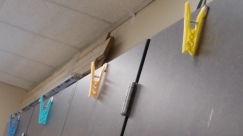
- My pencils kept disappearing. What to do? Use flower tape to put flowers in school colors on each pencil. Haven’t lost one since!
- When using whiteboards, students needed a way to erase. What to do? Hot glue pom-poms on the ends of white board markers. Or use felt cut in squares. Or use the dollar store microfiber wash clothes.
- Students use the microfiber wash clothes, but then they are a mess and thrown into odd places. What to do? Put a book ring in the corner and hang from marker tray with spring clips.

- I wanted to highlight math practices easily during a lesson. What to do? Make one-word sentence strips with magnets on the back and keep on the front board. When I want to highlight a particular practice or two used, I slide them over.
- I wanted to use Vertical Non-Permanent Whiteboards in class no place to actually put them up; you know, no wall space. What to do? Go to Lowe’s and purchase their 3×4 marker boards and put Target vinyl numbers in the corners.
- Calculator and iPad cords, and headphones get lost or left around the classroom. What to do? Get hooks and a special location to hang them so students know exactly where to find one to borrow and where to return.

- I hand out one copy of a directions for an activity but it ends up under paper, the supply tub or simply lost. What to do? Use the Dollar Tree giant stand-up paperclips to hold the paper up for all to see. I have also used acrylic photo stands from the Dollar Tree, but I use these more for station locations.
- I use lots of activities for my classes but storing them was such a hassle, and then I couldn’t find them easily. What to do? Go to Michael’s and purchase their plastic shoe boxes for cheap (wait for the 40% off sale or coupon) and label with chapter number using the Dollar Tree vinyl numbers. The activity cards go into quart or gallon sized plastic bags with sliders. I include the directions in the baggies.

- Supply tubs are a must in an activity-based classroom because handing out materials and collecting them can be a hassle/nightmare. I didn’t want the tubs on the group tables because there is little room on them already. What to do? Purchase shoe shelves and store them under the front table. Out from under foot, off of valuable counter space, yet easily accessible.

Bonus Hack: I use certain activities year after year, but I hate to keep re-copying them. Although I like to laminate certain things, I wonder about the long term effect of the plastic laminate in the landfills. What to do? Use sheet protectors! Although plastic, they can be reused if I decide to change out the activity. I simply binder-clip them together and store in the filing cabinet. 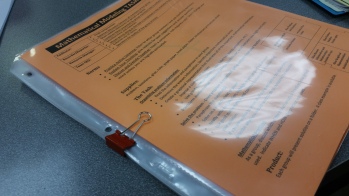
What are teacher hacks you have used that make a world of difference in your classroom?
Week -1: Organizing for Smooth Sailing through 2017-18
 This post is my contribution to this week’s #MTBoS Sunday Funday challenge: Classroom Management. I wouldn’t call it a “challenge” but rather an “invitation to blog” every week on a pre-selected topic. You then submit your blog post using this Google Form. On Sunday, Julie @jreulbach will post the week’s list of amazing blogs to go read! I can’t wait to read all of the goodness my peers have to offer!!
This post is my contribution to this week’s #MTBoS Sunday Funday challenge: Classroom Management. I wouldn’t call it a “challenge” but rather an “invitation to blog” every week on a pre-selected topic. You then submit your blog post using this Google Form. On Sunday, Julie @jreulbach will post the week’s list of amazing blogs to go read! I can’t wait to read all of the goodness my peers have to offer!!
This week’s challenge is “Everything Organization.” So I’ll share some of my “organizational” strategies with you.
Planning My Courses
I use an Excel spreadsheet to map out the year for each course. I used to use paper copies of this, but now I’ve gone electronic; easier to copy from year to year, easy to edit and easy to share with course colleagues. I can also color code….just love the colors! I love to plan out my year in detail (with the mental permission to change at will – you know, when a great idea shows up on a blog or Twitter or Pinterest or wherever) so I know I’ve got time for critical content and engagement activities. I used to hate when teachers took their time early in the year but then crammed so much in the last 3 weeks of a semester “because we got behind.” I purposely budget a couple of blank days later in each semester as “buffers” for unanticipated time needs.
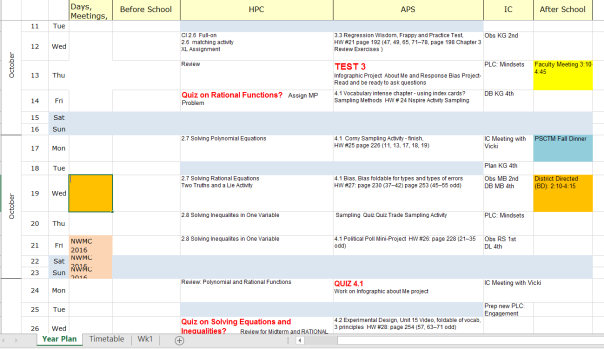
Create/Revise Learning Targets
I have learning targets for my course posted on my daily agendas (more info below) but after reading about #SBG and various blogs by @druinok, @mathequalslove, @samshah, @lisa_tilmon, among others, I decided to create ones I can share at the beginning of the year with students:
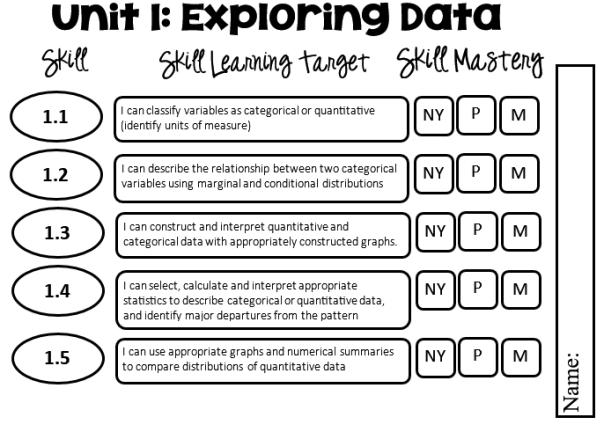
The code is: NY = Not Yet, P = Proficient, M = Mastered. I plan to include unit copies in my table folders (more on this below) so that each student can self-assess/communicate daily progress on the various critical learning targets for the unit.
Table Management: Roles and Resource Tubs
My students are in table groups of 4 for most days (except assessment times). I have used group roles (team captain, facilitator, reporter, resource manager) for years; this year I want the roles more visible to me and the others in the group. I saw this post by @mathequalslove and thought, “brilliant!” I made these puppies and put them in the group resource tubs, along with the red-yellow-green cups, set of 10 markers, rulers, highlighters and other materials. The resource manager picks up the tub for the group.
Table Folders
I’m trying a new management strategy I read about on blogs by Anna Vance at typeamathland.blogspot.com, @druinok at statteacher.blogspot.com, and Sam Shaw at samjshah.com. . My hope is that table folders streamline the processes of handing papers out, back and getting timely feedback from students through exit slips I collect daily. Although I haven’t worked out the entire procedure to teach my students yet, I think I’ve decided to have either the Team Captain pick up and return the folder every day or assign a Class Organizer each week to hand out folders to each table group daily along with other class jobs for the week.
How do you organize for a new school year?
Week -2: Classroom Management – Create a positive, well-managed classroom environment
 This post is my contribution to this week’s #MTBoS Sunday Funday challenge: Classroom Management. I wouldn’t call it a “challenge” but rather an “invitation to blog” every week on a pre-selected topic. You then submit your blog post using this Google Form. On Sunday, Julie @jreulbach will post the week’s list of amazing blogs to go read! I can’t wait to read all of the goodness my peers have to offer!!
This post is my contribution to this week’s #MTBoS Sunday Funday challenge: Classroom Management. I wouldn’t call it a “challenge” but rather an “invitation to blog” every week on a pre-selected topic. You then submit your blog post using this Google Form. On Sunday, Julie @jreulbach will post the week’s list of amazing blogs to go read! I can’t wait to read all of the goodness my peers have to offer!!
This week’s challenge is “Classroom Mangagement.” This stymied me because I have awesome kiddos every year, and the “typical” management issues just aren’t in my room. Not bragging except about how amazing my students are….they are in my room to learn, to experience new things and to have fun!
As I reflect, thought, I do believe these three things are critical for a smooth running classroom: be organized, be positive and authentic, keep students cognitively engaged. I find if my students understand expectations, feel safe, and have engaging experiences, the management issues usually don’t arise. So I’ll share some of my “management” strategies with you.
Be Organized
Know where you are going – so your kids will follow
I use an Excel spreadsheet to map out the year for each course. I used to use paper copies of this, but now I’ve gone electronic; easier to copy from year to year, easy to edit and easy to share with course colleagues. I can also color code….just love the colors! I love to plan out my year in detail (with the mental permission to change at will – you know, when a great idea shows up on a blog or Twitter or Pinterest or wherever) so I know I’ve got time for critical content and engagement activities. I used to hate when teachers took their time early in the year but then crammed so much in the last 3 weeks of a semester “because we got behind.” I purposely budget a couple of blank days later in each semester as “buffers” for unanticipated time needs.

Know what you want your kids to know, so they can show you.
I have learning targets for my course posted on my daily agendas (more info below) but after reading about #SBG and various blogs by @druinok, @mathequalslove, @samshah, @lisa_tilmon, among others, I decided to create ones I can share at the beginning of the year with students:

Share daily agendas
I learned this early in my career. If I I had a daily plan but didn’t share it with my students, we more often than not got derailed. Let students in on your plans for the day. We use a Learning Management System (LMS) at our school called Schoology, so I post the week’s agendas by Monday. One of the nice things is shared agendas actually build buy in; we all know what the learning and experiences for the day and work towards completing it. However, I also make adjustment right in front of the class if the agenda was too ambitious or an unexpected event (sing happy birthday, important school-wide announcement, xerox machine crashed, etc.) caused a loss of time. And the agendas are based on student feedback (see below for exit slips information). Attached to the agenda for the day are the required materials in electronic form; student simply download to Notability or Evernote. A great spin-off is that as students become accustomed to the procedure, when they are absent, they still check the daily agendas for what happened in class; they know it is the most up-to-date account of the class experience.
Be Positive and Authentic
Know how you want the classroom to run, so kids can embrace your vision
This is so, so important! Spend time thinking and envisioning what you truly want your classroom environment to look like, to sound like, and to be. It is important that you have a clear and solid vision so you can communicate to your charges through your words, actions, learning experiences and expectations. Remember, some of your students may never have experienced what you believe are characteristics of a perfect classroom environment. So dream away, read a lot and write it down. Be willing to try things, give yourself permission to make mistakes, listen to your students. Be careful, thought! Your classroom MUST FIT YOUR PERSONALITY not your classroom neighbor, your mentor teacher, your favorite blog author or whomever. Then, condense your vision into succinct words/phrases that embody your vision. Finally, think about how to foster those ideals in your classroom.
Know how your kids are doing, so let them tell you
Students need a way to voice how they are doing in class. Be aware, if you do this well, as students feel safe in your classroom, they will give you unsolicited feedback. This is really good (and a bit scary) so you need to be flexible and willing to listen and respond in an authentic way while also honoring what is important to you. Tricky stuff.
I use daily exit slips to take the pulse of my students’ academic, emotional and physical well-being. There are many places to collect great question and unique ways to elicit authentic feedback. Research supports that giving students time and space to reflect and self-assess their progress is a critical part of the learning. Eventually, you will be able to read your classes and create prompts that really work for them.
This year I plan to use the learning targets more purposefully. In the table folders (more next week), students will track for me where they believe they are in attaining the learning targets for the unit: NY = Not Yet, P = Proficient, M = Mastered. Each student will self-assess/communicate daily progress on the various critical learning targets for the unit.I will see these every day and this will also help me make timely adjustment to instruction and experiences.
Keep Students Cognitively Engaged
Openers/Bell Ringers/Starters…or whatever you call them!
There are so many ways to begin class, but my students know that they are to work on a task as soon as they walk in the door. The class procedure is to open your iPad, pull up the agenda and begin the Opener. To help students initially embrace this procedure, I use blatant bribery to reward those who get right to it. I covertly lay a piece of penny candy next students who immediately follow these three steps. Students in the group who don’t get the candy start asking immediately why they didn’t get one. I simply say, “you can figure it out,” and they usually do (or their peers fill them in). If, in good conscience, you can’t give students candy, find some other low stakes reward: raisins, pack of carrots, stickers.
My openers do one of three main things for the day:
- Recall yesterday’s learnings to gauge level of understanding
- Review foundational skills/concepts for today’s experiences,
- Set up today’s lesson with an exploration or data collection opportunity
Use Table Groups
My students are in table groups of 4 for most days (except assessment times) and this strategy is one of the most efficient yet effective management strategy I employ. I use group roles (team captain, facilitator, reporter, resource manager) and found the roles help with behavior management and student accountability too. I couldn’t imagine my class without the table group benefits of student talk, shared supplies, and peer support. There is so much information and support ideas on the web about using table groups! Just begin exploring.
By having students in groups it is very easy to use active engagement experiences because students are already used to working together. I use things like Desmos or Geogebra explorations, 15 minute posters and gallery walks, Musical chairs practice, Review Stations, etc. to use the power of group collaboration and problem-solving.
I didn’t expect this post to go on so long! And I have so much more to say!!! But maybe for a post later this year.
What are some management strategies you use that you couldn’t live without in your classroom? Would love to hear from you!
Week -3: Not Ready for a First Day Lesson
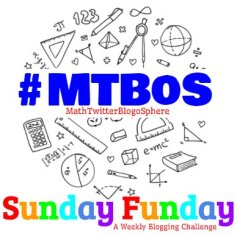 OMG!! School starts in 2.5 weeks, so I have NO.IDEA.WHATSOEVER about what I’m doing the first day or week. I’m still laying out my academic year and new, fun things for my classroom. So I’ll touch on some ideas I have for the first day/week, but instead I’ll share what I’ve been working on to get me to the first day. So here are some random things I’ve done this week:
OMG!! School starts in 2.5 weeks, so I have NO.IDEA.WHATSOEVER about what I’m doing the first day or week. I’m still laying out my academic year and new, fun things for my classroom. So I’ll touch on some ideas I have for the first day/week, but instead I’ll share what I’ve been working on to get me to the first day. So here are some random things I’ve done this week:
Standards Based Grading Musings
I am still waffling between 10-12 power standards for the year vs. 4-5 standards per unit. I am almost leaning toward using a Power standard (maybe essential learning?) as the umbrella with gradated/granulated stands in units that support the “bigger idea.” I’m almost envisioning a key word/phrase that exemplifies the Big Idea standard (ooh, I like that term!) and then connect to related focused standards that help students understand more clearly what is expected.
@lisatimon shared with me some of her #SBG items for Precalculus. I just loved the way she organized her study guides and how they highlight her identified standards for the unit. I’m not expecting to go full bore into #SBG this year, but want to build into my assessment a way to signal to students where the they demonstrates their level of knowledge/aptitude for an identified standard. Then I also want to include one to two items that require my kiddos to recognize the need for multiple standards in one setting and then expertly leverage them to complete the question. After reading some other blogs (Anna Vance at typeamathland.blogspot.com, @druinok at statteacher.blogspot.com, and Jared Derksen at mrmathman.com), I’m also leaning toward offering an opportunity to demonstrate mastery of a leveraging skill on a later assessment. I have had random questions from earlier topics on an assessment, but not purposefully. I know I need to do this more thoughtfully.
My course is “honors,” so students often grasp the basic skill relatively quickly but because they are so quick, they miss nuances that I want them to wrestle with. I find when they need to connect or recognize things in unfamiliar or unexpected situations, they falter. So I also try to incorporate rich tasks, and deeper thinking conceptual experiences…but I’m really struggling with how to quantify for a measurable standard. I see these learnings as developing over a long period of time rather than the couple of days for a new skill. That will be my next ponder.
I love summer, because I dream about what could be. Then I get hit smack in the middle of my forehead (with my hand) when reality sets in the second to third week. But this year, I definitely want to push myself toward using the power of SBG.
AP Stats Summer Work – Missed Assigning
Because I was at the AP grading during the last week of school, I missed the opportunity (actually poor planning during an extremely busy time) to get my summer work set up. Oh well! Just means I have to really move through our first chapter on Data Display and Analysis more quickly. Luckily, the Algebra 2 and Precalculus teachers did a statistics unit last year, so I am hopeful they will readily retrieve the learning – Make It Stick in action?
So I spent time creating a handout to go along with a new site shared on Twitter called Exploring Histograms. It is the first blush, but I think I want to use it during the first week of AP Statsistics.
Also thinking of using the Kristin Gilbert Activity again. Have to think it through as the last time I used it, I had mediocre results….probably the way I presented it.
Organizing for Group Work
I had to have some fun time creating and gathering for the school year. So here are some of the things I did:
- Group Tubs – got numbers put on them
- Group Roles and Tags – using Sara Carter at mathequalslove.blog‘s group tags, and yes, the hot gluing took longer than “a couple of minutes.”
- Group Folders – taking the leap based on blogs by Anna Vance at typeamathland.blogspot.com, @druinok at statteacher.blogspot.com, and Sam Shaw at samjshah.com. I am taking pieces and advice from each of them. Now I have to think about how to introduce to my students and develop a procedure…really like Sam’s Class Captain idea! Also decided to put little numbers in the upper left corner so my problem-solvers could find their group folder quickly.
- Random Group Assignments – I was looking for fun ways to create random groups and came across this lovely blog by Jenn Larson at The Teacher Next Door for some ideas. But the gem was at scholatic. I like the synomyms and antonyms for pairing. I’m thinking of printing another set of pairings (maybe pictures or mathy things) on two color card stock so I can pair by color and then group as 4. Also found a poster set of Einstein quotes; I created four of the same color for my groups of 4
I’ve gotta stop!! Time to get to work actually figuring out my standards for Precalculus and re-writing for AP Stats.
I’m really getting into Make It Stick – yeah, I know I’m late to the party – but the party is still going on. I plan to blog about this sometime, but I wonder if you have any thoughts about how you’ve introduced and then sustained the principles and strategies developed in Make It Stick. I would love to learn from you!!
Week -4: Goals and Dreams for 2017-18
 It has been a while since I blogged. I think my type-A, perfectionist over-exuberance at wanting to blog at what I envisioned was “top-level” just burned me out. But since getting back to Twitter (and getting in on the flurry of conversations about TMC, #MTBoS, and #PushSend ) I’ve realized that the reflective nature of blogging feeds my teacher soul.
It has been a while since I blogged. I think my type-A, perfectionist over-exuberance at wanting to blog at what I envisioned was “top-level” just burned me out. But since getting back to Twitter (and getting in on the flurry of conversations about TMC, #MTBoS, and #PushSend ) I’ve realized that the reflective nature of blogging feeds my teacher soul.
Last year I dropped blogging early in the school year because I was doing too much. And writing doesn’t come easy to me so my blogs were taking 1-2 hours to complete – I so admire those who type fast and write succinctly…can you school me?? Everything in my life was suffering and so blogging was the first (but not the last) thing to be purged. Now as I look back at the year this summer I realize the rest of my school year lost its glitter. Without the daily reflecting in writing via blogging and taking pictures of my kiddos while they were learning, the excitement fizzled and “Killer Routine” took over. Now don’t get me wrong, I did reflect but it tended to be quick, on the fly and lacked depth; I didn’t have a running commentary to look back on to review my progress, to relive the successes and to reminiscence about the changes that worked.
But I also realize I can’t keep up with blogging for each of the 180 days of the school year. So Blog 180 was out for me! As luck would have it, I learned through Twitter that during TMC17, Carl Oliver gave a keynote, Hitting the Darn ‘Send’ Button at TMC (Twitter Math Camp). He said just #PushSend; what you write doesn’t have to be perfect and what you have to say will resonate with someone. Most importantly for me I realized, the act of putting my thoughts to paper is an amazing growth experience. All of this talk about blogging inspired me. So I gave myself permission to blog once a week. In my mind I call it my new initiative: Blog 36+… I’ll blog once a week (but maybe more).
The stars aligned because soon after TMC, the #MTBoS got busy, spearheaded by Julie @jreulbach to revive the #MTBoS Sunday Funday challenge . I wouldn’t call it a “challenge” but rather an “invitation to blog” every week on a pre-selected topic; this week’s is Goals. You then submit your blog post using this Google Form. On Sunday, Julie will post the week’s list of amazing blogs to go read! I can’t wait to read all of the goodness my peers have to offer!! But I also realize I need to contribute….so my blogging life begins anew!
2017-2018 Goals and Dreams – at least planning for Goals
We don’t start school until August 30th, so my school brain is still on vacation! And I’m not sure I’m ready to have my goals set in “electronic stone” yet. So instead, I’ll share my first steps in creating goals for a new school year.
Here’s how I’ve done my goal-setting for many, many years. In early June, when I begin to get twinges of frustration and end-of-year-itis, I start my “Beginning of Year ‘##” folder. I’ve been doing this now for over 25 years and I really love to see how some things have come and gone, while others have become my pedagogical “rocks.”
*Wish I could get into my room to take a photo of all of my previous folders!!
On the inside left flap I have lots of categories: Goals, Keep-Change-Try, Theme/Focus. These help me think through the big picture for my classroom. Still adding thoughts as I read tweets and the many awesome blog posts shared this week!
- Goals include student, professional and personal goals for the year…these are actually the final culmination of the other things.
- Keep-Change-Try is just that, a running list of what I want to keep from my past practices, change or revise for the next year, and new things to try because they sound so promising.
- Theme/Focus is the catch phrase that encapsulates all of the above thinking, especially the goal. Usually a word or phrase that I post in big letters.
On the inside right flap I have lots of focuses that support the Goals and Theme: Engagement, Climate-Relationships, Retention, SBG, Technology, and Procedures.
- Engagement helps me think through authentic engagement experiences rather than “fun” activities that don’t move students’ learning forward.
- Climate-Relationships is a new focus for me this year. Although student evaluations say I do a great job at this, my personal perspective is that I need to work at this better to connect with EVERY student.
- Retention includes thoughts about how to insure long-term retention. This became a goal for our department last year (which I was so happy about – cartwheels in the aisles) so there was so much more collaboration around retention and how to help students with it.
- Standards Based Grading (SBG) is also a new addition, although I have been reading and thinking about it for a few years. I’ve found some good resources online, but don’t have any face-to-face colleague to share and reflect with…yay for Twitter. I am getting some help there.
- Technology has been an ongoing focus since I can remember! It is so fun to see how much technology has evolved over the years as well as how my practice in including it has changed so dramatically. And the use of technology has grown from just a tool to a learning-enhancing opportunity for students if used thoughtfully.
- Procedures is the last focus this year. I have been at this a long time, but every year some procedures need to change, mostly to keep my sanity and to make my classroom more studentcentric (is that even a word?!). Things that “bug” me in June are procedures crying out to be changed in August.
Already today, because of tweeting and reading blogs, my lists are expanding and evolving. So what are your goals and dreams for 2017-2018? Can’t wait to hear about them (and maybe revise mine based on your amazing thoughts) so just #pushsend!!
Should I Start Up Again? Or I Need More Personalized PD
It has been a very long time since I posted my last blog, and recently I realized I’ve been missing the deep reflection it provided. Starting up again has been a constant brain-tickle, but WOW what a time commitment!!
Then, just this morning while on Twitter, @druinok was also lamenting the loss of connection that blogging gives. She shared that she had just made a post (and then another in the same day) at her site: http://statteacher.blogspot.com/ Check it out because she is an amazing teacher and virtual colleague!! She even put out 4 ideas that I want to share (is that proper etiquette?) because they reflect where I have been these last few months.
- Engage in Twitter at least once per week.
- Read more blog posts.
- Blog. I need to be vulnerable and allow myself to share those same days.
- Read professionally.
That was the push I needed. Maybe I won’t do the daily posting (I tend to write too much and so spend too much time “perfecting” my grammar and prose…I guess that comes with being a math teacher rather than a language arts teacher: I lack the natural verbose style! So some thoughts around these 4 goals:
- About a month ago, I hit the Twitter app button on my phone after not having looked at it for 6 months – does time fly or what?! I felt like a small rowboat afloat in the Pacific ocean with no land in sight. I had no idea what anyone was talking about, what the current big issues in math education were, and felt like no one would remember who I was….not that they knew before, but at least I felt a part of the twitter community. I was embarrassed and flummoxed about what to share…did I really have anything worthwhile? But over the course of a few week, I followed treads, I “liked” and then began to “responded.” I even got a small back-and-forth with the Dan Meyer, can you believe it?! So I’m back at being addicted in a good way. I particularly like to follow @druinok, @mathequalslove, @gwaddellnvhs, @bobloch and #mtbos
- Again, about a 6 weeks ago (oh was that midwinter break?! when I had time to reflect and hunger for new ideas), I went to my blogroll and began clicking. I was saddened by how many were gone or hadn’t posted in a long while…but of course I hadn’t either, so look who’s talking? But it was great to even go back and reread posts and through each blogger’s personal sharing I found I was craving more. I really like to go to blogs because ideas are delved into more deeply, the activity is explained in more detail and often there are resources shared. It would be great to have a connection between the short “teasers” of Twitter coupled with the “deep dive” of blogs. These are some of my regular go to blogs: statsteacher, mathcoachblog, mathequalslove, Continuous Everywhere But Differentiable Nowhere, M^3(Making Math Meaningful) and
- Begin blogging…well, there’s no better time than the present!
- There are so many books I want to read, but the summer is filled with my non-school hobbies as well as reading for pleasure. I have a few professional tomes I’ve already bought and are sitting in my Kindle reader. Here are ones I hope to dive into: Statistics Done Wrong by Alex Reinhart, Creating Cultures of Thinking by Ron Ritchhart and finish Make It Stick by Peter Brown and Instant Relevance by Denis Sheeran. What are you planning to read this summer?
Quite a list, quite a manifesto, right?! I hope you will join me in adding depth to your professional development. Help me to stick to it! Add comments, tell me how you have engaged in social media, what new approach will you take to your own professional growth? We all need inspiration and comradery…join in the fun! Let the blogging begin!
Day 101: Logs in Life Peer Review
My precalculus students completed a project on logs and logistics function in real world. Before break, they signed up for a topic where logs or logistic functions are used. Students signed up for two possible topics and referenced them with an online site, which they submitted through a Google Form. Since Google Forms are time stamped, I able to use a first come, first served approach to topic assignment. I allowed up to 3 people to select the same topic, but after that, they got their second choice. Out of two classes, I only had 4 students that needed to determine a new topic.
Here is a brief synopsis of what was required:
THE TASK: The end product of your webquest will be a BROCHURE describing what you have learned about your chosen application of logarithms. • Brochure style (tri-folded) • Typed in your own words • Description and history of the application (e.g. “what is a decibel?” and “who invented the Richter scale?”) • Description of mathematics used in calculations – specifically logarithms with an example • Description of at least one career in which this application is used • At least one relevant graphic Citation of other websites used beyond the ones given (just list the url)
Students submitted both a physical copy and an electronic one. I created groups of brochures with different topics and none created by a particular group member.
Today they did the peer review of the brochures, again using a Google Form. I used radial buttons for the rubric part of the assessment. There was also a required comment section. I asked students to give both a positive comment about an intellectual aspect of the topic presentation and a constructive criticism. Part of their grade is their review of their peers and their peers’ review of their pamphlet. You could have heard a pin drop.
We had 10 minutes left in class, so I tried something on the fly…never know how that will go. I asked the groups to discuss and determine the most interesting brochure. They then passed that one on to the next group. Maybe this will be part of the whole process next year.
Day 100: Getting Ready for T3 in Orlando
I am sooooo excited. Once again I am heading to a Texas Instruments International Conference this year in Orlando, Flordia. As a TI Regional Instructor, I’ve run enough week-end workshops, attended enough PDs and helped out in other ways to earn a free round-trip air fare and hotel lodging for the 5 days! Since I will be presenting my Precalculus Folder Activity, I get a free registration! Whoot-whoot! I learn so much at these conferences. I think the T3 conferences have such great sessions and opportunities for collaboration with teachers from around the world as well as around the country. Love, love LOVE it!
The downside is prepping for a sub for 3 days. In my precalculus classes, not so bad as I will have them complete a Mathematics of Finance packet where they explore Present and Future interest situations. I usually have them do an online exploration of these rates by “shopping” for a home and then determining the going interest rate and their monthly payment. Also have them “invest” in an annuity to see how much they can make over a given time period. Since I won’t be there, I decided it would be too much for a “non-math” sub to handle. The packet still gives them some interesting situations to explore.
AP Stats is a different situation! They will have their test on confidence intervals on Wednesday, but then we are starting in on significance tests. So many places to develop misconceptions even when I’m there. So I spent almost 2 days over our mid-winter break just prepping for my absence in stats. I needed to re-write handouts and activities so my neo-statisticians could proceed without me. I also hunted for videos that would accurately explain concepts like p-values and alpha-levels, processes like writing hypotheses, and the general rationale behing a significance test. I think they will be in good virtual hands.


















































